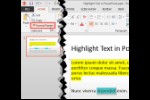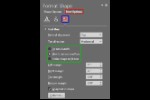Learn about various file types that can open and work in PowerPoint 2010 for Windows. This will help you work with more than just the default PowerPoint file formats.
Author: Geetesh Bajaj
Product/Version: PowerPoint 2010 for Windows
OS: Microsoft Windows XP and higher
We already created a tutorial on the file types that PowerPoint 2010 can save to, but when you go and look at the file types that PowerPoint 2010 can open, you'll find that the list of file types is not exactly the same. Several file types may be common but there are some surprises that you should explore. When you access the Open dialog in PowerPoint 2010, you can choose the file type you want to open (see Figure 1).

Figure 1: Open file type
Have you ever wondered what all those file types are? Should you even be concerned about them at all? We suggest you take a look for yourself:
Essentially any file you throw at PowerPoint, just in case you want to try your luck!
Since all these files are covered in later categories, we don't cover them here, please see subsequent category listings.
These are default PowerPoint file formats:
This file type is the default open option in PowerPoint 2007 and later. It is based on XML and can be distinctly identified as different from the older file formats for PowerPoint because it has four letters rather than three, for example PPTX rather than the older PPT format.
This file type was the default format for presentations created in PowerPoint versions 2003 and earlier. Most of the time, this is known as the PowerPoint 97 to 2003 format (or the PowerPoint 97 to 2004 format if you include Mac versions of PowerPoint).
This is identical to the PPTX file format other than the fact that file type creates presentations with macros enabled.
This file type comprises presentations that have been saved as a slide show. In all respects this is the same as a PPTX file, but when double-clicked, this opens in Slide Show view rather than Normal view. If you use the Open dialog, it opens in Normal view. See our PPT vs. PPS (or PPTX vs. PPSX) article.
This file type comprises presentations that have been saved as a slide show in PowerPoint 97 to 2003, in all respects this is the same as a PPT file, but when double-clicked, this opens in Slide Show view rather than Normal view. If you use the Open dialog, it opens in Normal view. See our PPT vs. PPS (or PPTX vs. PPSX) article.
This file type comprises presentations that have been saved as a slide show with macros enabled, and works in the same way as PPSX files.
This signifies XML (PowerPoint XML Presentation) presentations saved in an XML format for use in an XML information storage system.
Typically these files open as editable templates when you use the Open dialog box. On the other hand, if you double click these files, they open as new presentations based on the template:
This file type is a template that you can use as a starter for future presentations. This file format works with PowerPoint 2007 and subsequent versions of PowerPoint.
This file type is a template in PowerPoint 97 to 2003. You can still open and use these in newer versions of PowerPoint.
This file type is a template in the same way as POTX files, but with macros enabled.
These denote static web pages but for the most part, these were meant to be PowerPoint presentations that are saved as web pages by PowerPoint. When Microsoft released Office XP (that included PowerPoint 2002), they decided to make HTML output one of the main file formats for PowerPoint, and these files could be opened and edited like normal presentations in PowerPoint. They could also be opened in Internet Explorer and viewed like full screen presentations. Unfortunately, that was a half baked concept that did not work out, and HTML is no longer a file format that PowerPoint 2010 saves to, but for reasons of compatibility with older versions, the open option for HTML still works.
HTML output generally consisted of a single HTML file and a folder of the same name that contained all supporting files.
Same as HTML above, but this created a single MHT or MHTML file rather than a single HTML file with a folder containing supporting files.
These are THMX (Office Theme) files, choosing this option creates a new presentation based on the choosen Office Theme.
These are all outline formats that PowerPoint can import to create slides. All text in an outline is imported as text placeholders, see Text Boxes vs. Text Placeholders.
Text files, typically created by Notepad in Microsoft Windows (or TextEditin Mac OS X)
Rich Text Format files
Word 97 to 2003 files
Corel WordPerfect files
Corel WordPerfect files
Word 2007 and later versions create these files
Same as DOCX above, but includes macros
This file type opens presentations as an add-in that includes custom commands or VBA code. Typically used in PowerPoint 2007 or later versions.
This opens presentations as an add-in that you can open in PowerPoint 97 to 2003. Typically used in PowerPoint 2003 or earlier versions.
This opens ODP (OpenDocument Presentation) files, such as those created by Google Docs or OpenOffice.
01 08 02 - File Types, File Menu, and Backstage View: File Types That Can be Opened in PowerPoint (Glossary Page)
File Types That Can be Opened in PowerPoint 365 for Windows
File Types That Can be Opened in PowerPoint 365 for Mac
File Types That Can be Opened in PowerPoint 2019 for Windows
File Types That Can be Opened in PowerPoint 2016 for Windows
File Types That Can be Opened in PowerPoint 2016 for Mac
File Types That Can be Opened in PowerPoint 2013 for Windows
File Types That Can be Opened in PowerPoint 2011 for Mac
You May Also Like: Creating Multilingual Presentations: Conversation with Jude Barak | Plaids PowerPoint Templates




Microsoft and the Office logo are trademarks or registered trademarks of Microsoft Corporation in the United States and/or other countries.